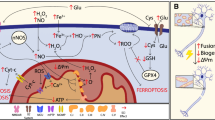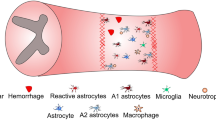Abstract
Spinal cord injury (SCI) is a type of long-term disability with a high morbidity rate in clinical settings for which there is no effective clinical treatment to date. Usually, lithium is used as a popular mood stabilizer. Recently, growing evidence has shown that lithium has clear neuroprotective effects after SCI, and the administration of lithium can effectively improve locomotor recovery. However, the exact neuroprotective mechanism of lithium is still not understood. Glycogen synthase kinase-3 beta (GSK3β) is a serine/threonine kinase that plays an important role in the neuroprotective effects of lithium both in vivo and in vitro. In this study, we discovered that lithium inhibits GSK3β activity through two different signaling pathways in spinal cord neurons. In the acute phase, lithium inhibited GSK3β activity by stimulating phosphorylation of AKT; in the chronic phase, we first discovered that lithium additionally upregulated the expression of Na+, K+-ATPase α1 (NKA α1), which had an inhibitory effect on GSK3β activity by inducing the expression of glucocorticoid inducible kinase 1 (SGK1). SGK1 is well known as a regulator of the GSK3β/β-catenin signaling pathway. Moreover, the suppressed activity of GSK3β increased the level of β-catenin in the cytoplasm, which gave rise to the translocation of the freely stabilized β-catenin to the nucleus. In addition, the accumulation of β-catenin in the nucleus had the benefits of neuronal survival. Hopefully our findings from this study are beneficial in revealing the neuroprotective mechanism of lithium and in offering novel targets for the development of new SCI therapeutic drugs.





Similar content being viewed by others
References
Thuret S, Moon LD, Gage FH (2006) Therapeutic interventions after spinal cord injury. Nat Rev Neurosci 7:628–643
Kalbhenn T, Mittlmeier T, Woiciechowsky C (2002) Late neurological deterioration 30 years following conservative treatment of a lower cervical spine fracture: a case report. Zentralbl Neurochir 63:77–80
Gu C, Zhang Y, Hu Q, Wu J, Ren H, Liu CF, Wang G (2017) P7C3 inhibits GSK3β activation to protect dopaminergic neurons against neurotoxin-induced cell death in vitro and in vivo. Cell Death Dis 8:e2858
Zakeri M, Afshari K, Gharedaghi MH, Shahsiah R, Rahimian R, Maleki F, Dehpour AR, Javidan AN (2014) Lithium protects against spinal cord injury in rats: role of nitric oxide. J Neurol Surg A Cent Eur Neurosurg 75:427–433
Chiu CT, Wang Z, Hunsberger JG, Chuang DM (2013) Therapeutic potential of mood stabilizers lithium and valproic acid: beyond bipolar disorder. Pharmacol Rev 65:105–142
He Z, Zhou Y, Wang Q, Li J, Zheng Z, Chen J, Zhang H, Wang Z, Xu H, Xiao J (2017) Inhibiting endoplasmic reticulum stress by lithium chloride contributes to the integrity of blood-spinal cord barrier and functional recovery after spinal cord injury. Am J Transl Res 9:1012–1024
Dill J, Wang H, Zhou F, Li S (2008) Inactivation of glycogen synthase kinase 3 promotes axonal growth and recovery in the CNS. J Neurosci 28:8914–8928
Valvassori SS, Dal-Pont GC, Resende WR, Jornada LK, Peterle BR, Machado AG, Farias HR, de Souza CT, Carvalho AF, Quevedo J (2017) Lithium and valproate act on the GSK-3β signaling pathway to reverse manic-like behavior in an animal model of mania induced by ouabain. Neuropharmacology 117:447–459
Beurel E, Grieco SF, Jope RS (2015) Glycogen synthase kinase-3 (GSK3): regulation, actions, and diseases. Pharmacol Ther 148:114–131
Yang W, Nam K, Ju JH, Lee KM, Oh S, Shin I (2014) S100A4 negatively regulates β-catenin by inducing the Egr-1-PTEN-Akt-GSK3β degradation pathway. Cell Signal 26:2096–2106
Gao K, Shen Z, Yuan Y, Han D, Song C, Guo Y, Mei X (2016) Simvastatin inhibits neural cell apoptosis and promotes locomotor recovery via activation of Wnt/β-catenin signaling pathway after spinal cord injury. J Neurochem 138:139–149
Shen Z, Zhou Z, Gao S, Guo Y, Gao K, Wang H, Dang X (2017) Melatonin inhibits neural cell apoptosis and promotes locomotor recovery via activation of the Wnt/β-catenin signaling pathway after spinal cord injury. Neurochem Res 42, 2336–2343
Xia M, Yang L, Sun G, Qi S, Li B (2017) Mechanism of depression as a risk factor in the development of Alzheimer’s disease: the function of AQP4 and the glymphatic system. Psychopharmacology 234:365–379
Brewer GJ, Torricelli JR (2007) Isolation and culture of adult neurons and neurospheres. Nat Protoc 2:1490–1498
Xia M, Zhu Y (2013) FOXO3 a involvement in the release of TNF-α stimulated by ATP in spinal cord astrocytes. J Mo Neurosci 51:792–804
Xia M, Zhu Y (2014) Fibronectin enhances spinal cord astrocyte proliferation by elevating P2Y1 receptor expression. J Neurosci Res 92:1078–1090
Li B, Zhang S, Zhang H, Hertz L, Peng L (2011) Fluoxetine affects GluK2 editing, glutamate-evoked Ca(2+) influx and extracellular signal-regulated kinase phosphorylation in mouse astrocytes. J Psychiatry Neurosci 36:322–338
Li B, Qi S, Sun G, Yang L, Han J, Zhu Y, Xia M (2016) Leptin suppresses adenosine triphosphate-induced impairment of spinal cord astrocytes. J Neurosci Res 94:924–935
Munzer JS, Daly SE, Jewell-Motz EA, Lingrel JB, Blostein R (1994) Tissue- and isoform-specific kinetic behavior of the Na,K-ATPase. J Biol Chem 269:16668–16676
Garty H, Lindzen M, Scanzano R, Aizman R, Füzesi M, Goldshleger R, Farman N, Blostein R, Karlish SJ (2002) A functional interaction between CHIF and Na-K-ATPase: implication for regulation by FXYD proteins. Am J Physiol Renal Physiol 283:607–615
Valenta T, Hausmann G, Basler K (2012) The many faces and functions of β-catenin. EMBO J 31:2714–2736
Zahler R, Zhang ZT, Manor M, Boron WF (1997) Sodium kinetics of Na,K-ATPase alpha isoforms in intact transfected HeLa cells. J Gen Physiol 110:201–213
Agrawal SK, Fehlings MG (1996) Mechanisms of secondary injury to spinal cord axons in vitro: role of Na+, Na(+)-K(+)-ATPase, the Na(+)-H+ exchanger, and the Na(+)-Ca2+ exchanger. J Neurosci 16:545–552
Fehlings MG, Agrawal S (1995) Role of sodium in the pathophysiology of secondary spinal cord injury. Spine 20:2187–2191
Lang F, Shumilina E (2013) Regulation of ion channels by the serum- and glucocorticoid-inducible kinase SGK1. FASEB J 27:3–12
Webster MK, Goya L, Ge Y, Maiyar AC, Firestone GL (1993) Characterization of sgk, a novel member of the serine/threonine protein kinase gene family which is transcriptionally induced by glucocorticoids and serum. Mol Cell Biol 13:2031–2040
Lang F, Strutz-Seebohm N, Seebohm G, Lang UE (2010) Significance of SGK1 in the regulation of neuronal function. J Physiol 588:3349–3354
Waldegger S, Barth P, Raber G, Lang F (1997) Cloning and characterization of a putative human serine/threonine protein kinase transcriptionally modified during anisotonic and isotonic alterations of cell volume. Proc Natl Acad Sci USA 94:4440–4445
Lang F, Bohmer C, Palmada M, Seebohm G, Strutz-Seebohm N, Vallon V (2006) (Patho)physiological significance of the serum- and glucocorticoid-inducible kinase isoforms. Physiol Rev 86:1151–1178
Jacobs KM, Bhave SR, Ferraro DJ, Jaboin JJ, Hallahan DE, Thotala D (2012) Gsk-3beta: a bifunctional role in cell death pathways. Int J Cell Biol 2012:930710
Wang X, Shi SH, Yao HJ, Jing QK, Mo YP, Lv W, Song LY, Yuan XC, Li ZG, Qin LN (2016) Electroacupuncture at dazhui (GV14) and mingmen (GV4) protects against spinal cord injury: the role of the Wnt/β-catenin signaling pathway. Neural Regen Res 11:2004–2011
Lu GB, Niu FW, Zhang YC, Du L, Liang ZY, Gao Y, Yan TZ, Nie ZK, Gao K (2016) Methylprednisolone promotes recovery of neurological function after spinal cord injury: association with Wnt/β-catenin signaling pathway activation. Neural Regen Res 11:1816–1823
Fu R, Tang Y, Ling ZM, Li YQ, Cheng X, Song FH, Zhou LH1, Wu W (2014) Lithium enhances survival and regrowth of spinal motoneurons after ventral root avulsion. BMC Neurosci 15:84
Song Z, Yang W, Zhou X, Yang L, Zhao D (2017) Lithium alleviates neurotoxic prion peptide-induced synaptic damage and neuronal death partially by the upregulation of nuclear target REST and the restoration of Wnt signaling. Neuropharmacology 123, 332
Acknowledgements
This study was supported by Grant No. 81200935 received by MX from the National Natural Science Foundation of China, Grant No. 20170541030 received by MX from the Natural Science Foundation of the Liaoning Province, Grant No. 201602834 received by BL from the Natural Science Foundation of Liaoning Province and Grant No. [2015]1098 received by BL from the Scientific Research Foundation for Overseas Scholars of Education Ministry of China.
Author information
Authors and Affiliations
Corresponding author
Ethics declarations
Conflict of interest
The authors have no conflicts of interest to declare.
Ethical Approval
All experiments were carried out in accordance with the National Institutes of Health’s Guide for the Care and Use of Laboratory Animals (NIH Publications No. 80–23) revised in 1978, and all experimental protocols were approved by the Institutional Animal Care and Use Committee of China Medical University.
Rights and permissions
About this article
Cite this article
Li, B., Ren, J., Yang, L. et al. Lithium Inhibits GSK3β Activity via Two Different Signaling Pathways in Neurons After Spinal Cord Injury. Neurochem Res 43, 848–856 (2018). https://doi.org/10.1007/s11064-018-2488-9
Received:
Revised:
Accepted:
Published:
Issue Date:
DOI: https://doi.org/10.1007/s11064-018-2488-9




